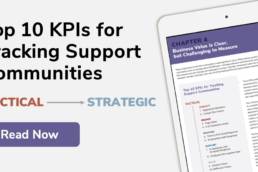I don’t know how many times I’ve had to shift a conversation into reverse when an initial business discussion about online communities begins with “We’re thinking about starting an online community. What’s your opinion of Platform X?”
Too many companies decide they want to invest in an online community — be it internal or externally-facing — and then move right to making the community platform acquisition decision without EVER considering the mission, vision and goals for the community. It’s like starting a business negotiation with “I want to buy something. What have you got to sell?” instead of “Here’s the problem I’m trying to solve … ”
When platform selection comes first, all the essential decisions about the community features, functions and engagement model will be based on whatever widget or components are built into the software package. Ultimately, crucial business needs and objectives have to be retrofitted into the features offered by the selected vendor’s product, rather than allowing the business requirements to guide the feature, function and design decisions. It’s really a backwards approach, no?
The most common reason for this is social business is still considered just a set of tools, rather than a powerful business process accelerator, innovation catalyst and organizational change agent. Many organizations don’t know how or don’t realize the necessity of investing time and energy in defining the strategic goals and objectives for the online community BEFORE they settle on features.
Sure, every community software platform has forums and blogs. But each platform deploys them in different ways, with different strengths and weaknesses. Absent a strategic plan on which to base the platform selection criteria, organizations risk making an enormous and expensive mistake if their platform of choice does not support the goals and processes implicit in their business objectives.
For example: A B2B company seeks to build an online community to support their customers’ use of an existing, expensive product or service. They will likely want a private (gated) community, a member directory linked to their existing CRM system and a rich analytical back end to identify high-value customers’ areas of topical interest in the community so the company can serve those customers better…and make more sales.
These business objectives generate a very specific set of technical and functional requirements, requirements which will only be fully revealed through the creation of a strategic community plan prior to vendor selection. If the vendor is chosen before or without developing the critical use cases and functional requirements specified by the community plan, the whole development process will be a crap shoot. Will the vendor have this feature set in their portfolio? Will the needed functional interconnections be feasible at reasonable cost? Will it scale? Will it be secure? Will you know how to find out ahead of time?
Metrics are another area where software selection prior to strategic planning can come back to haunt an organization. Sure, all software tools can tell you how many hits, likes, views and posts occur on the community. What’s missing is integrating with and reporting on business metrics! Most business metrics are unique to the organization or even the business unit. You need to define those business success measures before picking a vendor to be sure the platform’s back end can deliver the data you need.
When Boss Bob shows up at your desk 6 months after community launch and asks how many of the members are prospects vs. customers, the average sales for active vs. non-active community members and if buyers of the most recent service line are interested in X, Y, or Z topic in the community, you may have a problem if the software can’t help you answer those questions. Answering “I’ll have to check with the software vendor on getting that information…” is not a good career move.
Armed with a proper strategic plan, you can turn your business requirements into feature requirements and conduct a detailed and transparent vendor selection evaluation process. Prioritizing feature/function needs and asking the right questions will help you select a vendor who will meet your expectations. For example: if posting to discussions by email is a critical success factor (your users are mobile, email-driven professionals such as doctors and lawyers), you will know to ask for this feature and disqualify any vendor who does not. Extensible search functions which surface both content and discussions in the same search results may be important if your community offers a mix of thought leadership, user postings and training materials. You get the idea!
Treat the creation of online communities as you would any other line of business activity — a community is not just a marketing vehicle. Define the strategic outcomes you want from the community, specify the audience it will serve, develop the business metrics and measures needed to report outcomes and the operational plans to build and run the community over time. Then you can pick a platform and avoid a very costly and unnecessary mistake.
2 Comments
Add comment Cancel reply
This site uses Akismet to reduce spam. Learn how your comment data is processed.



I really believe you will do much better in the future I appreciate everything you have added to my knowledge base. Admiring the time and effort you put into your blog and detailed information you offer! roofing grapevine
I really believe that a lot of business don’t really understand how much work goes into building an online community. They just think that it is what they have to do and want to throw some money at it and hope it works.